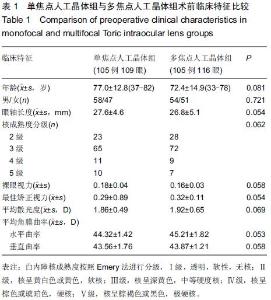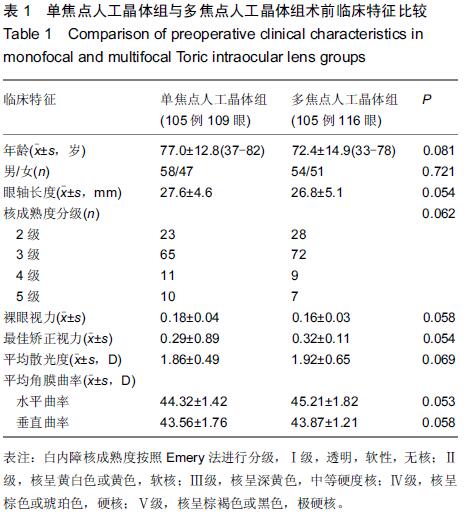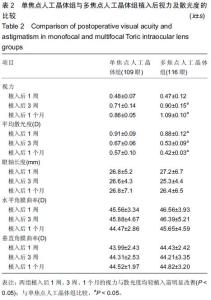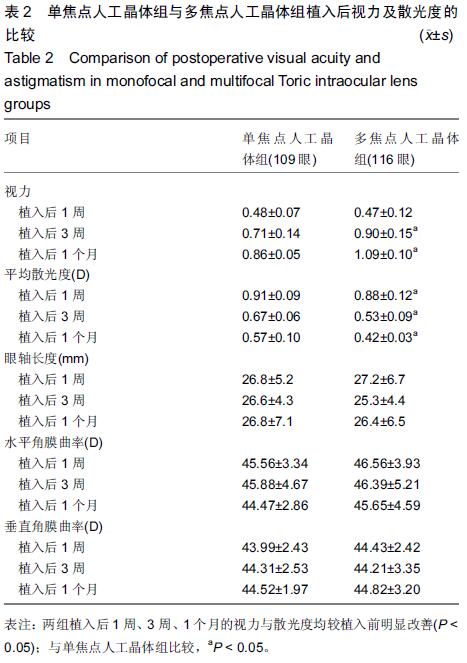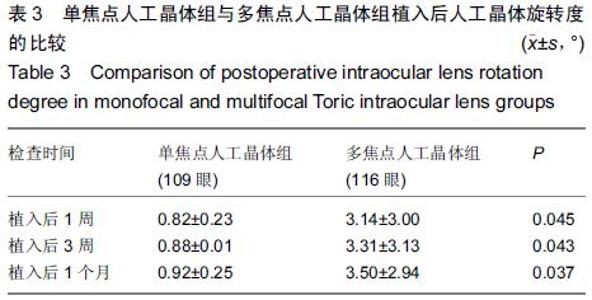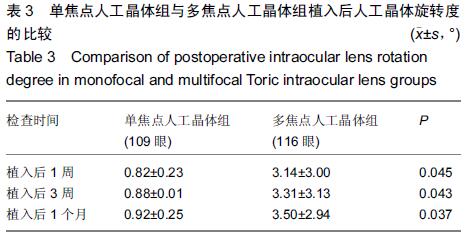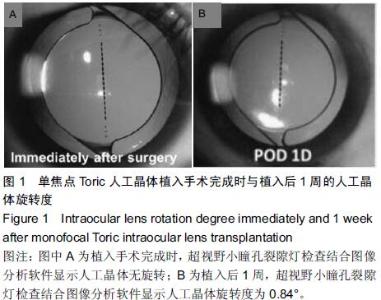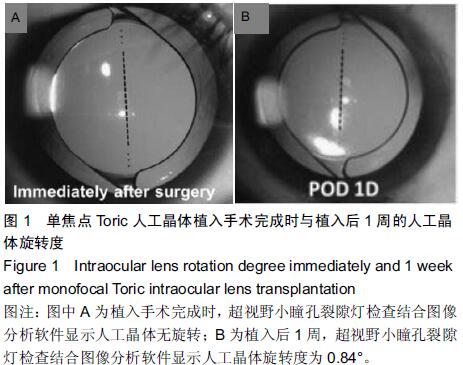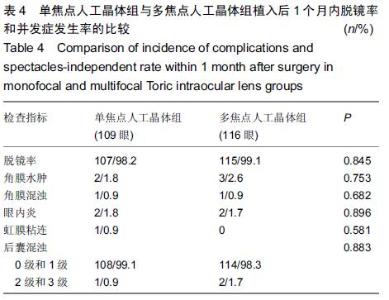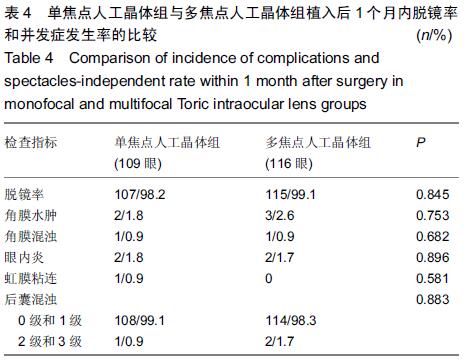Chinese Journal of Tissue Engineering Research ›› 2015, Vol. 19 ›› Issue (47): 7665-7670.doi: 10.3969/j.issn.2095-4344.2015.47.022
Previous Articles Next Articles
Influence of different intraocular lenses on postoperative benefit of cataract patients with astigmatism
Ju Chao-juan1, Chu Miao1, Zhang Qian1, Lin Wei2
- 1Department of Ophthalmology, the First Hospital of Hebei Medical University, Shijiazhuang 050031, Hebei Province, China; 2the First Affiliated Hospital of Hebei North University, Zhangjiakou 075000, Hebei Province, China
-
Received:2014-09-30Online:2015-11-19Published:2015-11-19 -
About author:Ju Chao-juan, Master, Attending physician, Department of Ophthalmology, the First Hospital of Hebei Medical University, Shijiazhuang 050031, Hebei Province, China
Cite this article
Ju Chao-juan, Chu Miao, Zhang Qian, Lin Wei. Influence of different intraocular lenses on postoperative benefit of cataract patients with astigmatism[J]. Chinese Journal of Tissue Engineering Research, 2015, 19(47): 7665-7670.
share this article
| [1] Pascolini D,Mariotti SP.Global estimates of visual impairment: 2010.Br J Ophthalmol.2012;96(5):614-618. [2] 郑宏,于普林,洪依舒,段春波,杨泽,高芳坤.我国城乡老年人白内障的患病情况调查[J].中华流行病学杂志,2001,22(6):6446- 6448.
[3] Hoffer KJ.Biometry of 7,500 cataractous eyes.Am J Ophthalmol.1980;90:360-368.
[4] Hoffmann PC,Hütz WW.Analysis of biometry and prevalence data for corneal astigmatism in 23,239 eyes.J Cataract Refract Surg.2010;36:1479-1485.
[5] Ferrer-Blasco T,Montés-Micó R,Peixoto-de-Matos SC,et al.Prevalence of corneal astigmatism before cataract surgery. J Cataract Refract Surg.2009;35:70-75.
[6] 赵江月,张劲松.散光人工晶状体在白内障摘除手术中的应用[J].国际眼科纵览,2008,31(4):258-260.
[7] 袁建树,马蓉,王育文.AcrysofToric人工晶状体矫正角膜散光的临床研究[J].现代实用医学,2012,23(12):1330-1336.
[8] 胡铮,赵家良,董方田,等.北京市顺义县白内障流行病学调查[J].中华眼科杂志,1989,25(6):360-364.
[9] Visser N, Beckers HJ, Bauer NJ,et al.Toric vs aspherical control intraocular lenses in patients with cataract and corneal astigmatism: a randomized clinical trial.JAMA Ophthalmol. 2014;132(12):1462-1468.
[10] Miyake T,Kamiya K,Amano R,et al.Long-term clinical outcomes of toric intraocular lens implantation in cataract cases with preexisting astigmatism.J Cataract Refract Surg. 2014;40(10):1654-1660.
[11] Shimoda T,Shimoda G,Hida WT,et al.Visual outcomes after implantation of a novel refractive toric multifocal intraocular lens.Arq Bras Oftalmol.2014;77(2):71-75.
[12] Holland E,Lane S,Horn JD,et al.The AcrySoftoric intraocular lens in subjects with cataracts and corneal astigmatism; a randomized, subject-masked, parallelgroup, 1-year study. Ophthalmology.2010;117:2104-2111.
[13] Freitas GO,Boteon JE,Carvalho MJ,et al.Treatment of astigmatism during phacoemulsification.Arq Bras Oftalmol. 2014;77(1):40-46.
[14] Maedel S,Hirnschall N,Chen YA,et al.Rotational performance and corneal astigmatism correction during cataract surgery: aspheric toric intraocular lens versus aspheric nontoric intraocular lens with opposite clear corneal incision.J Cataract Refract Surg. 2014;40(8):1355-1362.
[15] Bellucci R,Bauer NJ,Daya SM,et al.Visual acuity and refraction with a diffractive multifocal toric intraocular lens.J Cataract Refract Surg.2013;39(10):1507-1518.
[16] Visser N,Ru?z-Mesa R,Pastor F,et al.Cataract surgery with toric intraocular lens implantation in patients with high corneal astigmatism.J Cataract Refract Surg.2011;37:1403-1410.
[17] Gayton JL,Seabolt RA.Clinical outcomes of complex and uncomplicated cataractous eyes after lens replacement with the AcrySoftoricIOL.J Refract Surg.2011; 27:56-62.
[18] Hasegawa Y,Okamoto F,Nakano S,et alT.Effect of preoperative corneal astigmatism orientation on results with a toric intraocular lens.J Cataract Refract Surg.2013;39(12): 1846-1851.
[19] Venkataraman A; Kalpana.Visual outcome and rotational stability of open loop toric intraocular lens implantation in Indian eyes.Indian J Ophthalmol.2013;61(11):626-629.
[20] Iovieno A,Yeung SN,Lichtinger A,et al.Cataract surgery with toric intraocular lens for correction of high corneal astigmatism.Can J Ophthalmol.2013;48(4):246-250.
[21] Lee JY,Kang KM,Shin JP,et al.Two-year results of AcrySof toric intraocular lens implantation in patients with combined microincision vitrectomy surgery and phacoemulsification.Br J Ophthalmol.2013;97(4):444-449.
[22] Alió JL,Peña-García P,Abdulla Guliyeva F,et al.MICS with toric intraocular lenses in keratoconus: outcomes and predictability analysis of postoperative refraction.Br J Ophthalmol.2014;98(3):365-370.
[23] Einan-Lifshitz A,Barkana Y,Goldich Y,et al.Results of cataract surgery with Z-flex hydrophilic acrylic toric IOL.Eur J Ophthalmol. 2013;23(3):333-338.
[24] Lyall DA,Srinivasan S,Ng J,et al.Changes in corneal astigmatism among patients with visually significant cataract.Can J Ophthalmol.2014;49(3):297-303.
[25] Roensch MA,Charton JW,Blomquist PH,et al.Resident experience with toric and multifocal intraocular lenses in a public county hospital system.J CataractRefract Surg.2012; 38:793-798.
[26] Scialdone A,De Gaetano F,Monaco G.Visual performance of 2 aspheric toric intraocular lenses: comparative study.J Cataract Refract Surg.2013;39(6):906-914.
[27] Ferreira TB, Marques EF, Rodrigues A, Montés-Micó R.Visual and optical outcomes of a diffractive multifocal toric intraocular lens.J Cataract Refract Surg.2013;39(7):1029-1035.
[28] 郑登易,叶剑,谭薇.多焦点、可调节和单焦点人工晶状体临床视觉质量的观察[J].第三军医大学学报,2012,34(4):354-357.
[29] 叶盼盼,姚克,李霞,等.双眼植入Tecnis多焦点和单焦点球面人工晶状体的临床比较研究[J].中华眼科杂志,2010,46(7):625-630.
[30] Felipe A,Artigas JM,Díez-Ajenjo A,García-Domene C,et al.Residual astigmatism produced by toric intraocular lens rotation.J Cataract Refract Surg.2011;37(10):1895-1901.
[31] Prinz A,Neumayer T,Buehl W,et al.Rotational stability and posterior capsule opacification of a plate-haptic and anopen-l oop-haptic intraocular lens.J Cataract Refract Surg.2011; 37: 251-257.
[32] Lombardo M,Carbone G,Lombardo G,et al.Analysis of intraocular lens surface adhesiveness by atomic force microscopy.J Cataract Refract Surg.2009;35:1266-1272.
[33] Oshika T,Nagata T,Ishii Y.Adhesion of lens capsule to intraocular lenses of polymethylmethacrylate, silicone, and acrylic foldable materials: an experimental study.Br J Ophthalmol.1998;82:549-553.
[34] Linnola RJ,Sund M,Ylönen R,et al.Adhesion of soluble fibronectin, vitronectin, and collagen type IV to intraocular lens materials.J Cataract Refract Surg.2003;29(1):146-152.
[35] Linnola RJ,Werner L,Pandey SK,et al.Adhesion of fibronectin, vitronectin, laminin,and collagen type IV to intraocular lens materials in pseudophakichuman autopsy eyes. Part 1: histological sections.J Cataract Refract Surg.2000;26:1792-1806.
[36] Krall EM,Arlt EM,Jell G,et al.Prospective Randomized Intraindividual Comparison of Posterior Capsule Opacification After Implantation of an IOL With and Without Heparin Surface Modification.J Refract Surg.2015;31(7):466-472.
[37] Krall EM,Arlt EM,Jell G,et al.Intraindividual aqueous flare comparison after implantation of hydrophobic intraocular lenses with or without a heparin-coated surface.J Cataract Refract Surg.2014;40(8):1363-1370.
[38] Shah GD,Praveen MR,Vasavada AR,Vasavada VA,et al. Rotational stability of a toric intraocular lens: influence of axial length and alignment in the capsular bag. J Cataract Refract Surg.2012;38:54-59.
[39] Prinz A,Neumayer T,Buehl W,et al.Rotational stability and posterior capsule opacification of a plate-haptic and an open-loop-haptic intraocular lens. J Cataract Refract Surg. 2011; 37:251-257. |
| [1] | Zhang Tongtong, Wang Zhonghua, Wen Jie, Song Yuxin, Liu Lin. Application of three-dimensional printing model in surgical resection and reconstruction of cervical tumor [J]. Chinese Journal of Tissue Engineering Research, 2021, 25(9): 1335-1339. |
| [2] | Zeng Yanhua, Hao Yanlei. In vitro culture and purification of Schwann cells: a systematic review [J]. Chinese Journal of Tissue Engineering Research, 2021, 25(7): 1135-1141. |
| [3] | Xu Dongzi, Zhang Ting, Ouyang Zhaolian. The global competitive situation of cardiac tissue engineering based on patent analysis [J]. Chinese Journal of Tissue Engineering Research, 2021, 25(5): 807-812. |
| [4] | Wu Zijian, Hu Zhaoduan, Xie Youqiong, Wang Feng, Li Jia, Li Bocun, Cai Guowei, Peng Rui. Three-dimensional printing technology and bone tissue engineering research: literature metrology and visual analysis of research hotspots [J]. Chinese Journal of Tissue Engineering Research, 2021, 25(4): 564-569. |
| [5] | Chang Wenliao, Zhao Jie, Sun Xiaoliang, Wang Kun, Wu Guofeng, Zhou Jian, Li Shuxiang, Sun Han. Material selection, theoretical design and biomimetic function of artificial periosteum [J]. Chinese Journal of Tissue Engineering Research, 2021, 25(4): 600-606. |
| [6] | Liu Fei, Cui Yutao, Liu He. Advantages and problems of local antibiotic delivery system in the treatment of osteomyelitis [J]. Chinese Journal of Tissue Engineering Research, 2021, 25(4): 614-620. |
| [7] | Li Xiaozhuang, Duan Hao, Wang Weizhou, Tang Zhihong, Wang Yanghao, He Fei. Application of bone tissue engineering materials in the treatment of bone defect diseases in vivo [J]. Chinese Journal of Tissue Engineering Research, 2021, 25(4): 626-631. |
| [8] | Zhang Zhenkun, Li Zhe, Li Ya, Wang Yingying, Wang Yaping, Zhou Xinkui, Ma Shanshan, Guan Fangxia. Application of alginate based hydrogels/dressings in wound healing: sustained, dynamic and sequential release [J]. Chinese Journal of Tissue Engineering Research, 2021, 25(4): 638-643. |
| [9] | Chen Jiana, Qiu Yanling, Nie Minhai, Liu Xuqian. Tissue engineering scaffolds in repairing oral and maxillofacial soft tissue defects [J]. Chinese Journal of Tissue Engineering Research, 2021, 25(4): 644-650. |
| [10] | Xing Hao, Zhang Yonghong, Wang Dong. Advantages and disadvantages of repairing large-segment bone defect [J]. Chinese Journal of Tissue Engineering Research, 2021, 25(3): 426-430. |
| [11] | Chen Siqi, Xian Debin, Xu Rongsheng, Qin Zhongjie, Zhang Lei, Xia Delin. Effects of bone marrow mesenchymal stem cells and human umbilical vein endothelial cells combined with hydroxyapatite-tricalcium phosphate scaffolds on early angiogenesis in skull defect repair in rats [J]. Chinese Journal of Tissue Engineering Research, 2021, 25(22): 3458-3465. |
| [12] | Wang Hao, Chen Mingxue, Li Junkang, Luo Xujiang, Peng Liqing, Li Huo, Huang Bo, Tian Guangzhao, Liu Shuyun, Sui Xiang, Huang Jingxiang, Guo Quanyi, Lu Xiaobo. Decellularized porcine skin matrix for tissue-engineered meniscus scaffold [J]. Chinese Journal of Tissue Engineering Research, 2021, 25(22): 3473-3478. |
| [13] | Mo Jianling, He Shaoru, Feng Bowen, Jian Minqiao, Zhang Xiaohui, Liu Caisheng, Liang Yijing, Liu Yumei, Chen Liang, Zhou Haiyu, Liu Yanhui. Forming prevascularized cell sheets and the expression of angiogenesis-related factors [J]. Chinese Journal of Tissue Engineering Research, 2021, 25(22): 3479-3486. |
| [14] | Liu Chang, Li Datong, Liu Yuan, Kong Lingbo, Guo Rui, Yang Lixue, Hao Dingjun, He Baorong. Poor efficacy after vertebral augmentation surgery of acute symptomatic thoracolumbar osteoporotic compression fracture: relationship with bone cement, bone mineral density, and adjacent fractures [J]. Chinese Journal of Tissue Engineering Research, 2021, 25(22): 3510-3516. |
| [15] | Liu Liyong, Zhou Lei. Research and development status and development trend of hydrogel in tissue engineering based on patent information [J]. Chinese Journal of Tissue Engineering Research, 2021, 25(22): 3527-3533. |
| Viewed | ||||||
|
Full text |
|
|||||
|
Abstract |
|
|||||
